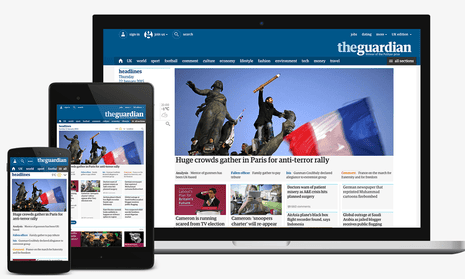The Guardian has a history stretching back almost 200 years of creating world-class journalism. In more recent times, the Guardian has also become one of the world’s most influential news organisations with newsrooms in the UK, the US and Australia.
The Guardian has reached more than 110 million unique browsers worldwide in a month, while our readership in the UK also continues to grow. On any given day, Guardian readers are using thousands of different types of devices to read, view, discuss and share our journalism with each other. The amount of device types on which you can access the Guardian will only continue to increase so we want to make sure that we always provide you with a consistent, fast-loading, familiar and pleasurable experience, whatever your screen size.
Today we are launching a new site which has been built and designed from the ground up by the Guardian’s in-house team of designers, journalists, user-experience architects, product managers, developers and software engineers.
The new Guardian site presents you with a more compact view of the news agenda as it changes throughout the day and night. The new design will also give you more visual clues about each story’s relative importance and its editorial tone, whether it is a breaking news story or a live blog, a piece of analysis, a piece of opinion, a feature or a review.
Our videos, photo galleries and interactives are now more seamlessly integrated into everything we publish, instead of treating them as separate areas of the site. Videos can now be embedded and played anywhere within our homepages and articles.
And where we own the necessary rights to them, you can embed Guardian videos into your own site or blog.

Our new photo galleries allow you to either scroll through the images, swipe through them on mobile devices or to view them in an opulent full-screen mode while using your keyboard’s arrow-keys to browse through them. You can also choose to view all the images in one story in gallery view.

Your comments in discussion threads can now also be presented in the first screen of an article and not only below the fold.
And within each article, our editors now have many new ways of recommending related material to you so that you can more easily find the most pertinent analysis or opinion piece that refers to a news report or vice versa.

We have also made our topic pages easier to browse by grouping content by date, either by day or month depending on the amount of stories we have published. You can see some examples here and here.
Our new live blogs make it much easier to stay up-to-date during an unfolding news or sports event. A bullet point list gives you the essence of the story, while a separate list of key events allows you to quickly scan what has happened since you have visited that blog last. And if you like football, you might have noticed already that our new match stats and league tables are now integrated into the live blogs.
The Guardian’s journalists are voracious readers themselves and often know where to find the most interesting pieces of journalism from our competitors each day. “Why not share these insights with our readers?”we thought, and have added a collection of daily recommendations to our new homepage, called “what we are reading”.
The new site’s navigation contains a personalised element which allows you to quickly visit the areas of the site you go to most often. You can access these personal links by clicking on the “browse all sections” button on your desktop computer or the “all” button on your mobile screen. A preferences page allows you to edit or to deactivate these personalised links.
A third of all visits to the Guardian each month contain a view of the homepage or one of our section homepages and the more loyal a reader becomes, the more often she or he tends to visit the homepage, which is why we have also invested a good amount of time into studying how our readers are actually using our homepage.

From personally interviewing our readers around the world and from anonymised data analysis, we learned that there are three main motives to visit our homepage. We call them “update”, “extend” and “discover”.
“Update” is by far the most frequent motive and describes the journey of readers who visit the Guardian – often many times a day – to find out about the news-agenda in general, or about news from their area of interest, whether it is sports, culture, the economy or any other topic the Guardian covers each day.
“Extend” describes the motivation to then gain a deeper understanding of a specific story which usually demands more time than a quick news update.
The third motive, “discover”, is rather a whole group of motives, such as the wish to find inspiration and surprise, new perspectives, interesting debates with other readers or entertainment.
These research insights have guided us in testing and developing homepages and section pages that are not just reflections of a newsroom’s internal organisation – foreign, home, business, culture, sport and so on – but reflections of our readers’ typical journeys and needs.
To make sure we are getting this right, we developed the new site completely out in the open. Starting in early 2014, we introduced a prototype of the new site to 5% of our desktop readers around the world and asked them for their feedback. And if you are a developer and want to take a closer look at the site’s inner working, most of our code is on github, a publicly accessible code repository.
Thousands of readers took part in this project and have provided us with more than 130,000 pieces of detailed feedback . In addition, we have personally interviewed hundreds of readers in the UK, the US and Australia and have also analysed how millions of our anonymous readers were using our new site each day while we were constantly releasing new versions of it. (If you are interested in a more detailed account of what we learned from your feedback and what we have done about it, please read this blogpost by Nick Haley, the Guardian’s director of user experience.)
After studying what was really happening on our beta homepage each day, we then decided to take a new route and have developed a set of building blocks which we call “containers”.
The new homepages and each article page are made up of various such containers or modules. These do exactly what their slightly technical name suggests. They “contain” words, pictures, videos, graphics and data. Our editors can group them together flexibly and within minutes by topic, by story type, by tone or by importance.
So instead of building one big page according to a rigid template – news here, features there – our editors can create modular homepages and article pages to create a representation of what is important each and every day and then also embed these collections directly in other article pages so that the majority of readers who won’t visit the homepage can still get the most out of the Guardian.
While designing, building and testing the Guardian’s new site, our in-house team has also built a new set of editorial tools for our journalists to create and publish their stories. These new tools will give our journalists many new capabilities to publish with much more ease and to enrich their journalism with original material from the web whenever this can provide more context to a story.
Our team will continue to develop this new site and will keep releasing little changes to it every day.
We are aware of how different this new site is from what our most loyal readers have been used to since our last relaunch in 2007. The Guardian owes a lot to its old site and to the brilliant team that built and maintained it for so many years. Yet we also realised – across all departments and teams – that the time had come to completely renew the site so it can support the Guardian’s and the Observer’s mission in the years to come and serve you, wherever you are in the world and whichever device you are using.
We thank you all for your continued feedback and we hope you will enjoy the new site and come back often.

Comments (…)
Sign in or create your Guardian account to join the discussion